Key takeaways:
- Selective mutism is an anxiety disorder that causes children to remain silent in certain social situations, highlighting the need for understanding and support.
- Micro-interventions involve small, supportive actions that encourage communication and build trust, such as gentle prompts or creating a safe environment.
- Celebrating small victories and maintaining consistent follow-up can significantly enhance a child’s confidence and willingness to communicate.
- Involving peers and tailoring interventions to individual needs can foster a more inclusive atmosphere that facilitates improved communication skills.
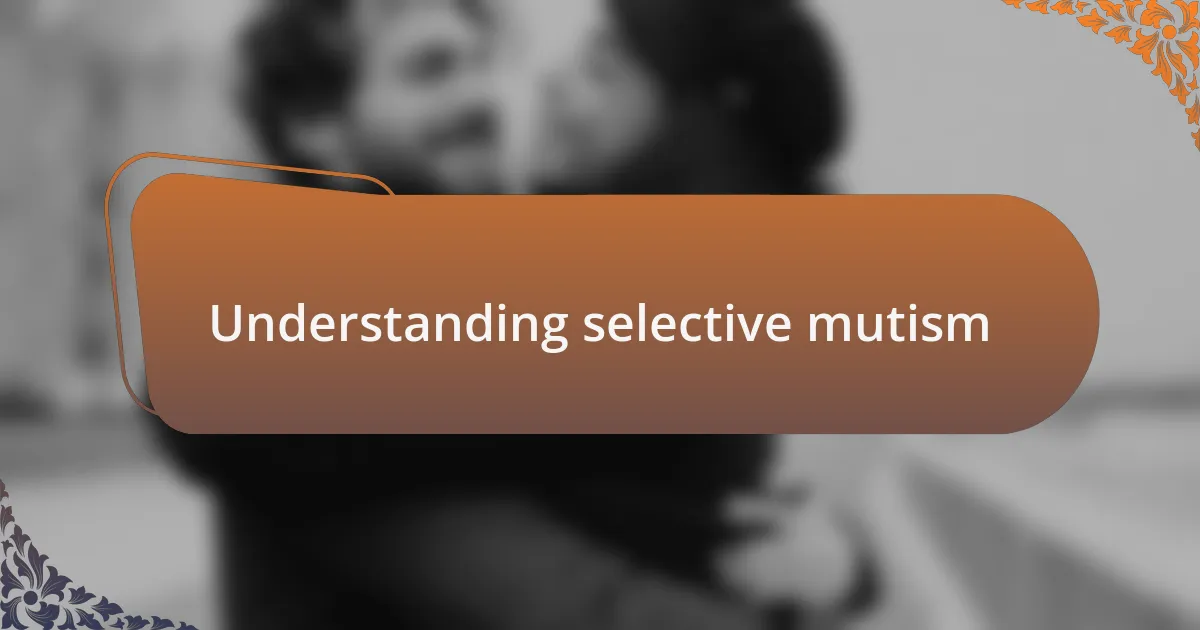
Understanding selective mutism
Selective mutism is a complex anxiety disorder that primarily affects children, leading them to refrain from speaking in certain social situations, despite being capable of communicating in other settings. I remember a time when I observed a little girl, who was vibrant and chatty with her family, suddenly become silent when faced with unfamiliar peers. It made me realize how overwhelming the pressure of social interaction can be for some children.
Understanding selective mutism means recognizing the deep-rooted fear that triggers this behavior. It’s not just shyness; it’s an intense anxiety response. Have you ever felt the weight of expectation in a crowded room? Many children experience that same pressure on a daily basis, rendering them mute in the face of perceived judgment. This anxious silence often creates a cycle of frustration, both for the children and for those around them, as they navigate understanding and support.
The journey toward helping a child with selective mutism requires compassion and patience. I’ve seen the transformative effect of gentle encouragement—like a soft nudge that reminds them they’re safe to express themselves. Every little victory, such as a whispered word or a brave attempt, is worth celebrating. When we approach with empathy, we can help break the silence that holds them captive.
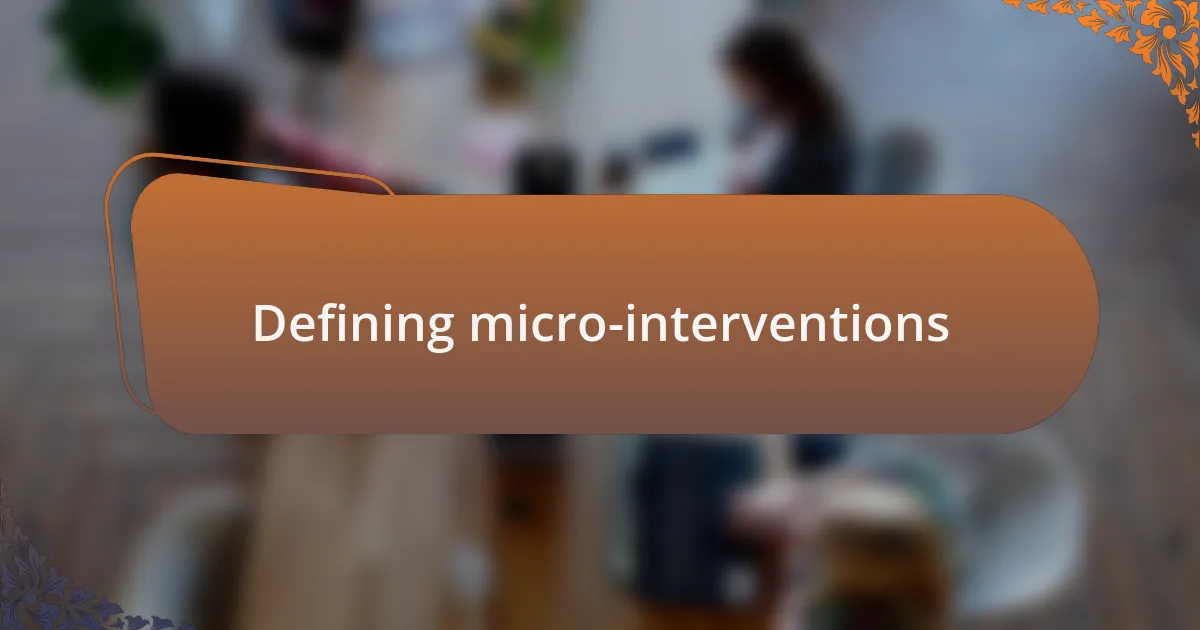
Defining micro-interventions
Defining micro-interventions involves looking at the small, often subtle actions and strategies that can make a significant impact on encouraging communication in children with selective mutism. I’ve often noticed how a simple nod or smile can create a warm atmosphere, prompting a child to feel more secure and open. It’s these tiny gestures, almost invisible yet powerful, that can shift the tide in helping a child find their voice.
These interventions can range from a gentle prompting in a one-on-one setting to creating a supportive environment where the child feels less pressure to speak. I recall a moment during a group activity when a teacher quietly invited a shy child to share without overwhelming her with attention. The child took a breath and spoke up, and that single moment revealed the profound effect of a carefully timed micro-intervention. Have you ever considered how such small shifts can change a person’s experience in a moment?
Moreover, micro-interventions are about integrating these small actions into everyday interactions, helping to build trust and reduce anxiety. I think back to how I would often use soft, encouraging phrases while reading with a group of children. The goal was to create space for even the quietest ones to participate at their comfort level. It’s a reminder that every word matters, and sometimes a single effort can spark change in the most unexpected ways.
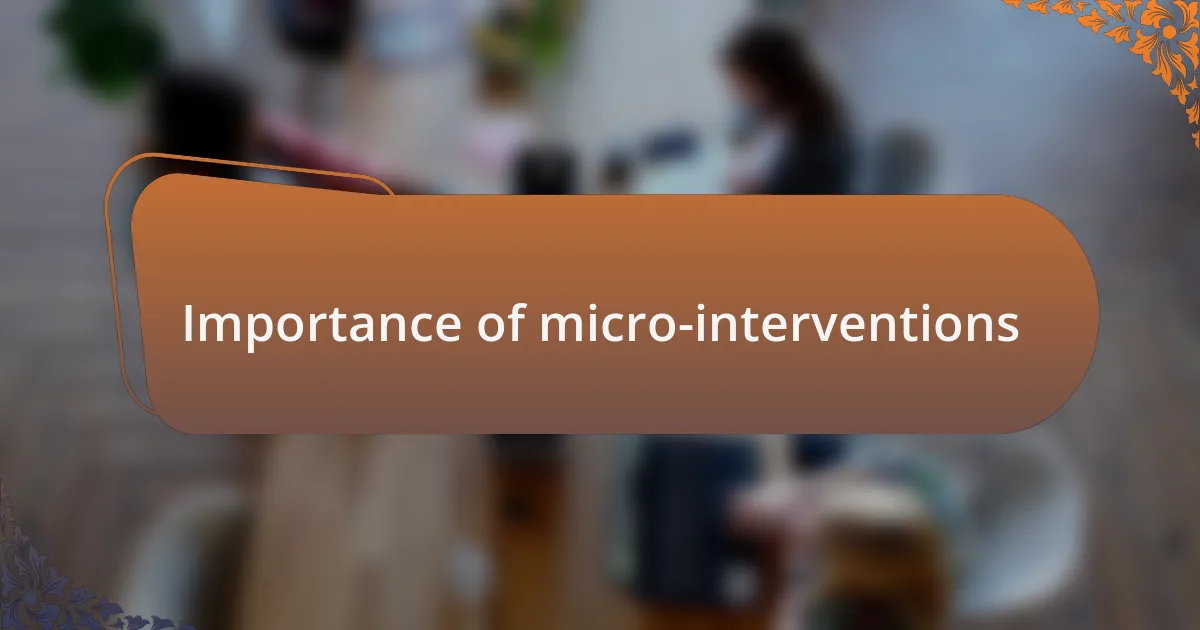
Importance of micro-interventions
Micro-interventions play a crucial role in fostering communication and reducing anxiety for children with selective mutism. I remember a time when I was working with a child who rarely spoke in class. A small gesture, like placing a supportive hand on their shoulder, seemed to create a bubble of safety that encouraged them to share their thoughts. Isn’t it fascinating how such a simple act can foster trust and prompt a child to express themselves?
These subtle actions can transform a daunting experience into a welcoming one. Once, during a quiet group project, I made it a point to acknowledge each child’s contributions, no matter how small. When I noticed one child’s eyes light up at a compliment, it became evident that the right kind of micro-intervention could lift their spirits and encourage further participation. Have you ever thought about the ripple effect that a little encouragement can have on someone’s willingness to communicate?
What I find particularly significant is how consistent micro-interventions can nurture long-term growth. For instance, I once conducted regular sessions focused on encouraging speech through play. By integrating micro-interventions, such as allowing each child a turn to share ideas at their own pace, I witnessed a gradual but notable increase in their comfort level. These moments shaped not just their ability to speak but also built their confidence, making the power of micro-interventions unmistakably clear.
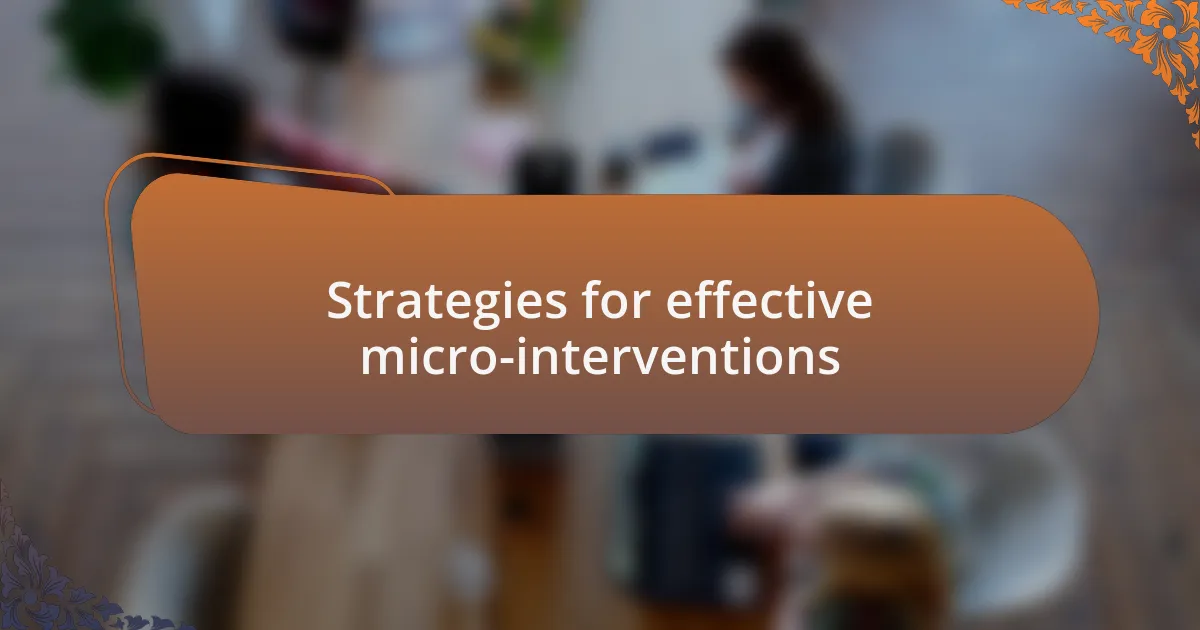
Strategies for effective micro-interventions
Effective micro-interventions begin with creating a safe environment. I vividly remember a workshop where I sat quietly beside a young word-shy student, sharing a book without expecting her to read aloud. This non-threatening presence eased her anxiety, allowing her to express excitement over the illustrations. How often do we consider that our mere presence can be an invitation to open up?
Another powerful strategy is to use modeling through storytelling. During a session, I shared a personal experience of overcoming shyness, recounting how I stumbled over my words in a similar setting. Watching the children relate to my story and slowly lean in, eager to share their tales, reminded me that vulnerability breeds connection. Isn’t it remarkable how sharing our own challenges can catalyze courage in others?
Lastly, I believe in tailoring interventions to each child’s unique needs. For example, I once had a child who thrived when given specific prompts rather than open-ended questions. By asking well-crafted, simple questions related to their interests, I witnessed a gradual unlocking of their voice. Have you ever noticed how a little guidance can lead someone to bloom in unexpected ways? This strategic support is essential for fostering meaningful communication.
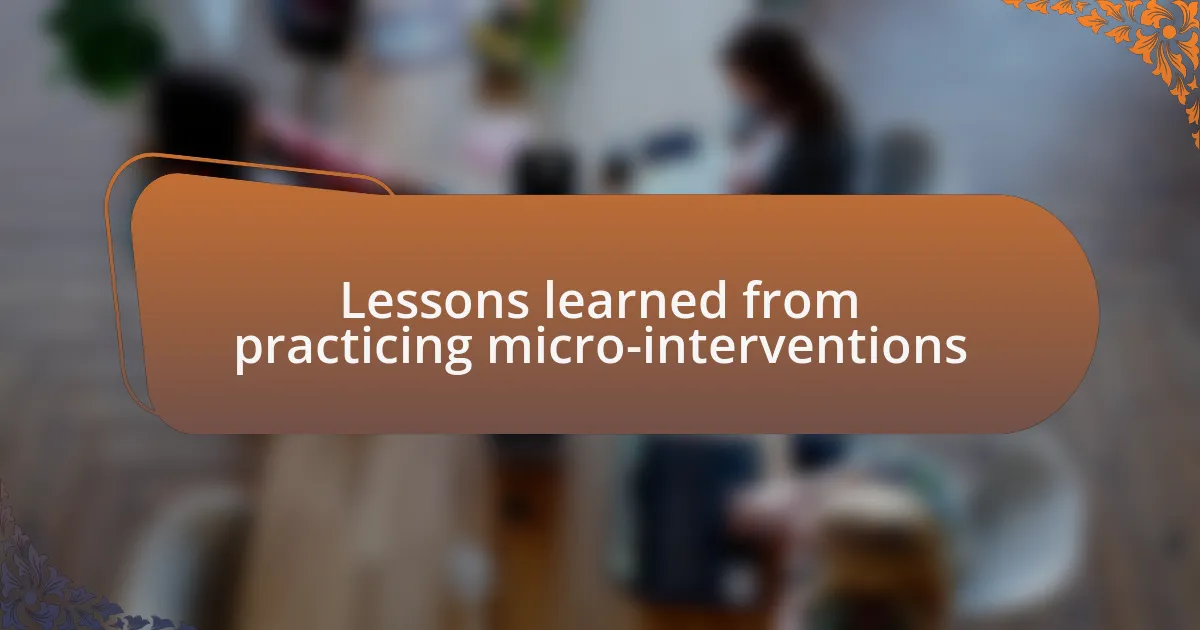
Lessons learned from practicing micro-interventions
Practicing micro-interventions has taught me the significance of patience. I recall an encounter with a child who would barely whisper in response to questions. I realized that instead of rushing to fill silences, I needed to embrace them. Those moments of quiet offered a gentle space for her to gather her courage. Have you experienced how silence can be a powerful tool in communication?
One lesson I took to heart is that celebrating small victories can have a profound impact. I remember one session where a child managed to make eye contact for the first time. The joy radiating from her face was unforgettable. A simple smile or nod can be monumental in a child’s journey. Isn’t it amazing how acknowledging these little milestones can ignite a sense of accomplishment and motivation?
Additionally, I’ve learned the importance of follow-up in building trust. After introducing micro-interventions in a group setting, I often checked in with each child afterward. One girl expressed her gratitude for the individual attention, saying it made her feel seen. Engaging in these follow-up conversations reinforced the idea that every child thrives on connection. How often do we seize the opportunity to check in and cultivate those bonds?
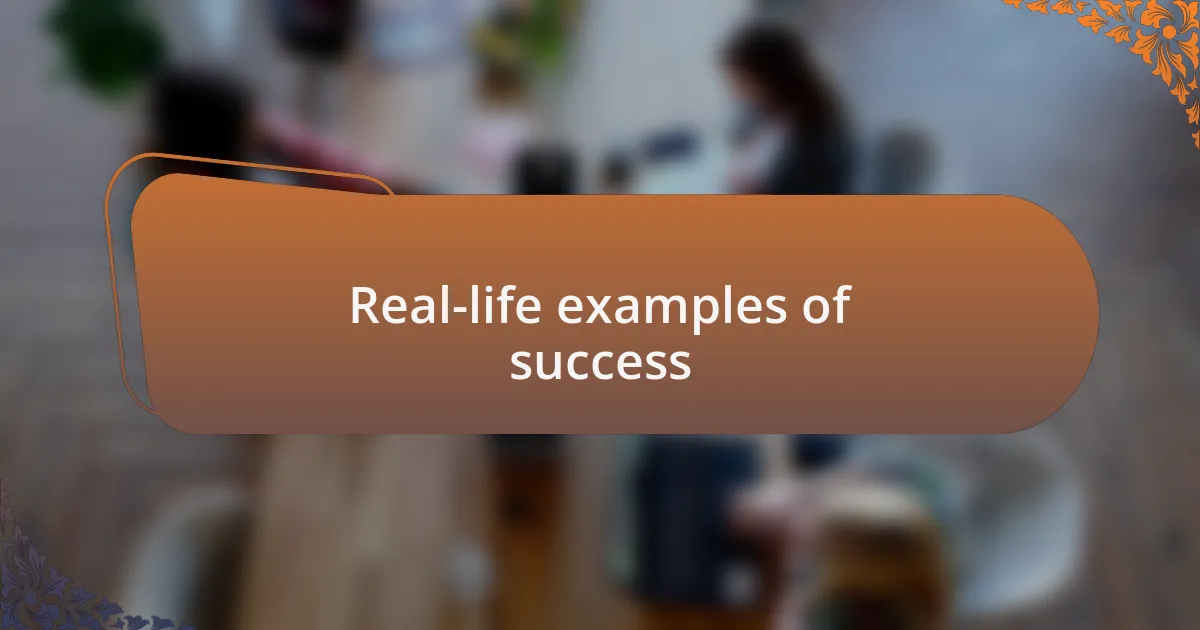
Real-life examples of success
There’s a remarkable story I encountered of a girl who initially refused to speak in class. After implementing micro-interventions, like using visual cues and engaging activities, she slowly found her voice. One day, she astonished everyone by initiating a conversation with her peers about her favorite book. Have you ever witnessed such a transformation, where a child’s smile lights up the room through newfound confidence?
Another success story revolves around a boy who struggled to ask simple questions. By incorporating gestures and role-playing into our sessions, he gradually became more comfortable interacting. The pivotal moment came when he confidently asked a teacher for help during a presentation. It was an emotional moment that reinforced my belief in the power of small steps leading to significant change. Isn’t it fascinating how even the smallest acts can open the door to bigger opportunities?
I also remember a remarkable case in a counseling group where a child, who used to communicate only through writing, finally spoke aloud. One day, she shared her thoughts on a group project without any prompts. The look of surprise on her face mirrored the tears of joy from her parents when they learned of her breakthrough. Have you ever experienced that rush of happiness when someone breaks through their barriers? That moment reminded me why persistent encouragement and gentle nudges matter so much in helping children with selective mutism.
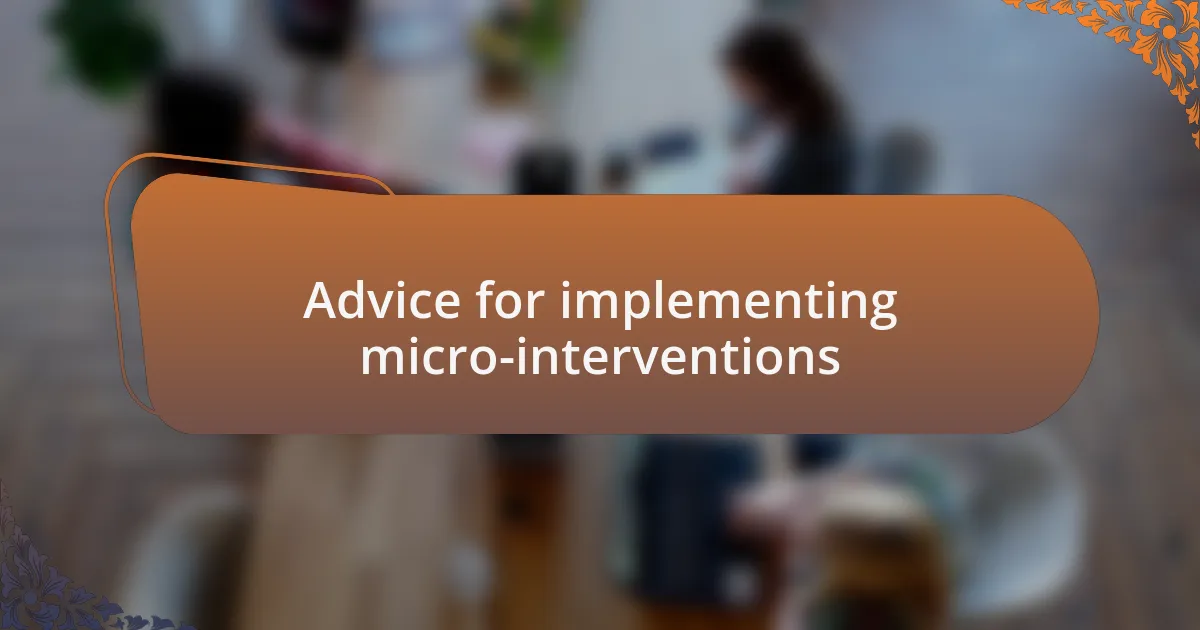
Advice for implementing micro-interventions
Implementing micro-interventions requires a thoughtful approach. I’ve found it crucial to tailor strategies to each child’s unique interests and comfort levels. For instance, I once introduced a favorite toy into a session as a conversation starter, which not only eased the child into speaking but also sparked genuine excitement. Have you considered how familiar objects can create a more welcoming environment for kids?
One key aspect I’ve observed is consistency in practice. Small, repeated actions can build a child’s confidence over time. I remember using simple, structured prompts during group activities; by routinely encouraging kids to respond in a low-pressure setting, I noticed an increase in their willingness to communicate. It’s interesting how trust can blossom from predictable interactions, isn’t it?
Additionally, involving peers in the process can be immensely beneficial. I once facilitated a session where children worked together on a project and included roles that promoted interaction without pressure. The collaborative nature created a safe space for everyone, leading to genuine dialogue among them. How often do we underestimate the power of peer support in fostering communication skills? The transformative power of micro-interventions truly shines when the environment is inclusive and engaging.